Onion farming is an important agricultural activity in Kenya. Onions are a versatile crop that can be used as a food ingredient, spice, or even natural medicine. Onion farming in Kenya usually takes place in small-scale operations, with farmers growing onions for local and export markets. Kenya is well-suited for onion production, thanks to its climate and soils. Onion farming in Kenya typically begins with the planting of seedlings in nurseries.
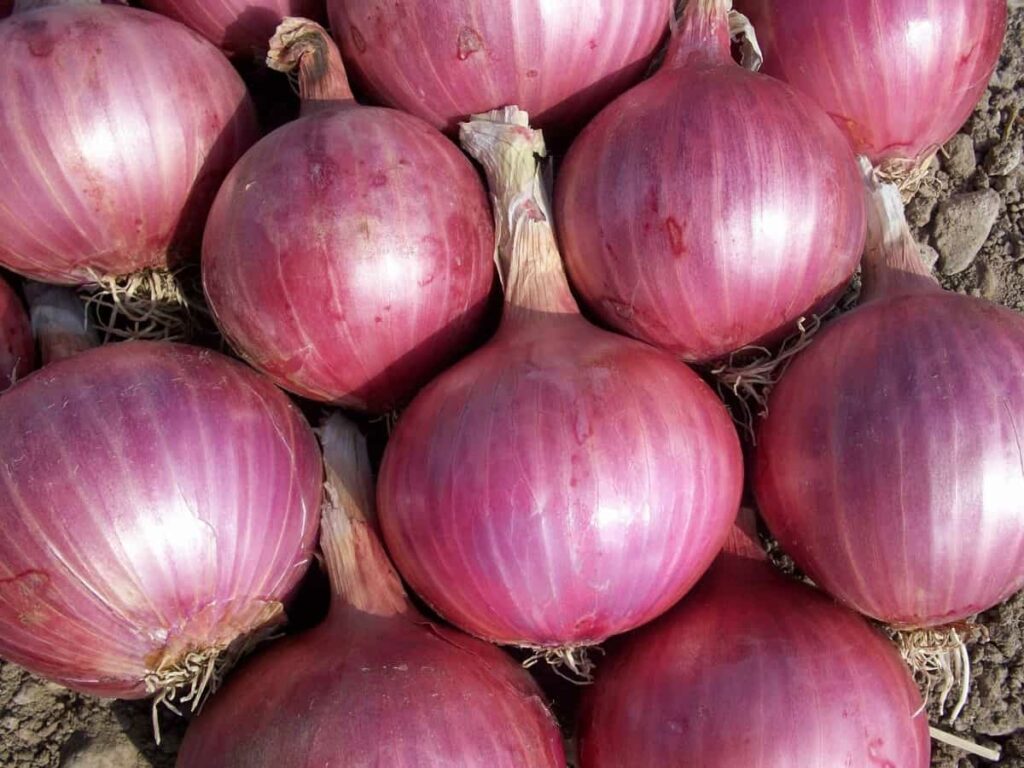
Once the seedlings are large enough, they are transplanted into the fields. Farmers must carefully monitor their onion crops, as onions are susceptible to pests and diseases. Harvesting usually takes place after four to five months. Nevertheless, onion farming can be a profitable venture for Kenyan farmers. With the right knowledge and management practices, farmers can produce high-quality onions in demand by both local and export markets.
A complete guide to onion farming in Kenya
Step-by-step guide for onion farming in Kenya
Preparing the soil for onion farming is critical to ensuring a successful harvest. Here are some tips on preparing the soil for your onion farm:
- Choose the right location. Onion plants need full sun and well-drained soil. Avoid planting onions in low-lying areas where they may be susceptible to rot.
- Test the soil. Before planting, it’s important to test the soil to ensure it’s rich in nutrients. For example, onion plants require a pH level between 5.8 and 6.8.
- Amend the soil. If necessary, add the soil with compost or any other organic matter to improve drainage and provide nutrients.
- Till the soil. Once the location and soil are prepared, it’s time to till the soil to loosen it up and create a bed for planting.
- Plant your onions. Now that the soil is loose and fertile, it’s time to plant your onions! Be sure to space them evenly, so they have room to grow.
What is the best time to plant onions in Kenya?
The ideal time to plant onions in Kenya is during the rainy season. This is because onions require a lot of water to grow properly. The rainy season in Kenya typically lasts from April to June.
When to water your onions in Kenya?
Watering onions is a critical part of onion production. Too little water and the onions will not develop properly. Too much water and the onions will rot. The key is to keep the soil moist but not soggy. Onions are typically watered every 3-5 days during the growing season. However, the frequency may need to be increased during periods of extended dry weather.
If a drip irrigation system is in place, onions can be watered to moisten the soil. If you need help determining when to water your onions, check the top layer of the soil. If the soil feels dry, it is time to water.
In case you missed it: Hybrid High Yield Onions Varieties in India: For Rabi, Kharif, Late, and Early Kharif

How to set up drip irrigation for your onion farm in Kenya?
Drip irrigation is an efficient way to water your onion farm in Kenya. By applying water directly to the roots of your plants, you can reduce water waste and achieve better crop yields. Setting up drip irrigation on your farm can be a simple or complex process, depending on the size and layout of your farm. Here are some tips, and ideas on how to set up drip irrigation for your onion farm in Kenya:
- Choose the right type of drip irrigation system. There are many different types of drip irrigation systems available on the market. First, you must select a system appropriate for your farm’s climate and soil conditions.
- Design your drip irrigation system. Once you have selected the right system for your farm, you need to design it effectively and efficiently. This includes deciding where to place emitters, how many emitters to use, and what type of tubing to use.
- Install your drip irrigation system. Once you have designed your system, it’s time to install it. This involves digging trenches or installing raised beds, running tubing, and connecting emitters.
- Test your drip irrigation system. Once you have installed your system, it’s important to test it to ensure it works properly. This includes checking for leaks and making sure each emitter is working correctly.
- Maintain your drip irrigation system. Proper maintenance is essential for keeping your drip irrigation system working properly. This includes regular cleaning.
How to control weeds in Onions in Kenya?
Weeding is one of Kenya’s most important cultural practices for Onion production. Onions are very sensitive to competition from weeds, and even a few weeds can significantly reduce yield. Therefore, it is important to remove weeds early and often to prevent yield loss. There are different ways to control weeds in Onions. One method is mechanical control, which includes hand-weeding, hoeing, and using a tine weeder.
This method is labor-intensive but can be effective if done regularly. Another method of weed control is chemical control, which involves using herbicides. Herbicides can be applied before, after, or during the growing season. Some herbicides are available as pre-mixed products, while others must be mixed with water before application. The ideal way to control weeds is to use a combination of both mechanical and chemical methods.
How to thin onion plants in Kenya?
Thinning onion plants is an important part of the growing process in Kenya. It allows the plants to focus their energy on producing fewer but larger onions. Thinning also helps to prevent overcrowding and promotes air circulation, which reduces the risk of fungal diseases. To thin onion plants, use your fingers or a small gardening tool to remove excess seedlings around each plant’s base carefully. Be sure to leave enough space between plants so that they have room to grow. Thinned seedlings can be transplanted to other garden areas or disposed of.
In case you missed it: Onion Farming in Tamilnadu: A Helpful Production Guide for Beginners
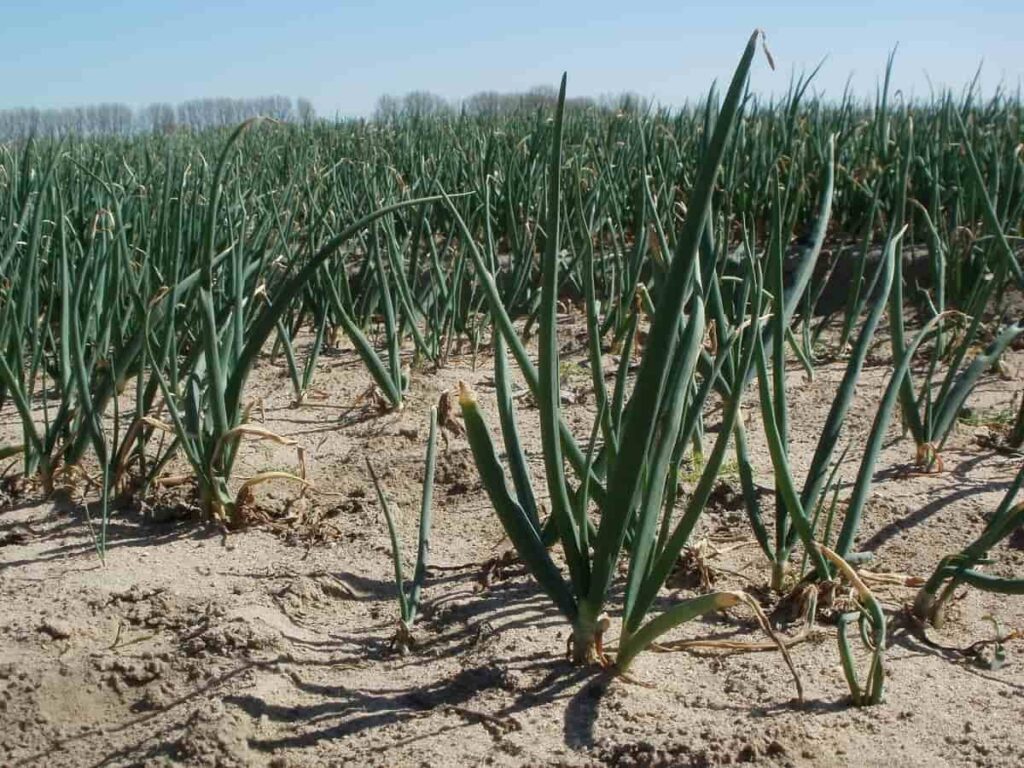
How to mulch onion plants in Kenya?
Mulching is an important part of onion plant care in Kenya. A thick layer of mulch in the onion field helps to retain moisture in the soil, prevent soil erosion, suppress weeds, and keep the roots cool. The best time to mulch onion plants is after the freshly tilled soil and before planting.
When selecting a mulch for your onion plants, choose an organic material such as straw, hay, leaves, or grass clippings. Avoid using plastic or synthetic materials, as these can overheat the soil and damage the roots. Apply a 5 to 7-cm layer of mulch around each plant, being careful not to pile it too high against the stem. Mulching onion plants is just one way to ensure a bountiful harvest.
Which fertilizer is best for onions in Kenya?
Many different types of fertilizer can be used on onions in Kenya, but not all are equally effective. Generally, the best fertilizer for onions in Kenya is high in nitrogen and low in phosphorus. This fertilizer will help promote strong growth and large bulb size. However, choosing a fertilizer that is well-suited to your area’s specific soil and climate conditions is important. One popular type of fertilizer for onions in Kenya is called DAP fertilizer.
This fertilizer is made from a blend of nitrogen, phosphorus, and potassium and is known for its ability to promote strong growth. Another popular option is called NPK fertilizer. This type of fertilizer is also high in nitrogen but contains a higher proportion of phosphorus and potassium. These two nutrients are essential for healthy onion growth but can be toxic in high concentrations.
As such, it is important to choose an NPK fertilizer specifically designed for onions in Kenya. Whichever fertilizer you choose, apply it according to the manufacturer’s instructions. Over-fertilizing can damage your onions, so following the recommended application rates is important.
Successful onion farmers in Kenya
Kenya is one of the world’s leading onion producers, and farmers here have developed various methods to ensure a successful harvest. One key to success is proper irrigation, and many farmers use drip systems to water their onions. Drip irrigation is a highly efficient method of watering that delivers water directly to the roots of the plants, minimizing evaporation and maximizing the amount of water the plants can use.
Another important factor in successful onion farming is selecting the right variety for your climate. There are wide varieties of onions, each requiring different temperatures, rainfall, and other conditions. Farmers in Kenya have access to a wide range of onion varieties, and they often try different types to see which ones will do best in their fields.
Finally, it’s important to keep on top of pest and disease control. Onions are susceptible to many pests and diseases, so farmers need to be vigilant to protect their crops. They may use various methods, including chemical sprays, traps, and even companion planting (planting other crops alongside the onions that help repel pests). By following these simple tips, farmers in Kenya can produce large quantities of high-quality onions year after year.
In case you missed it: Roma Tomato Growing Guide: For Pots, Ground, Raised Beds, and Buckets
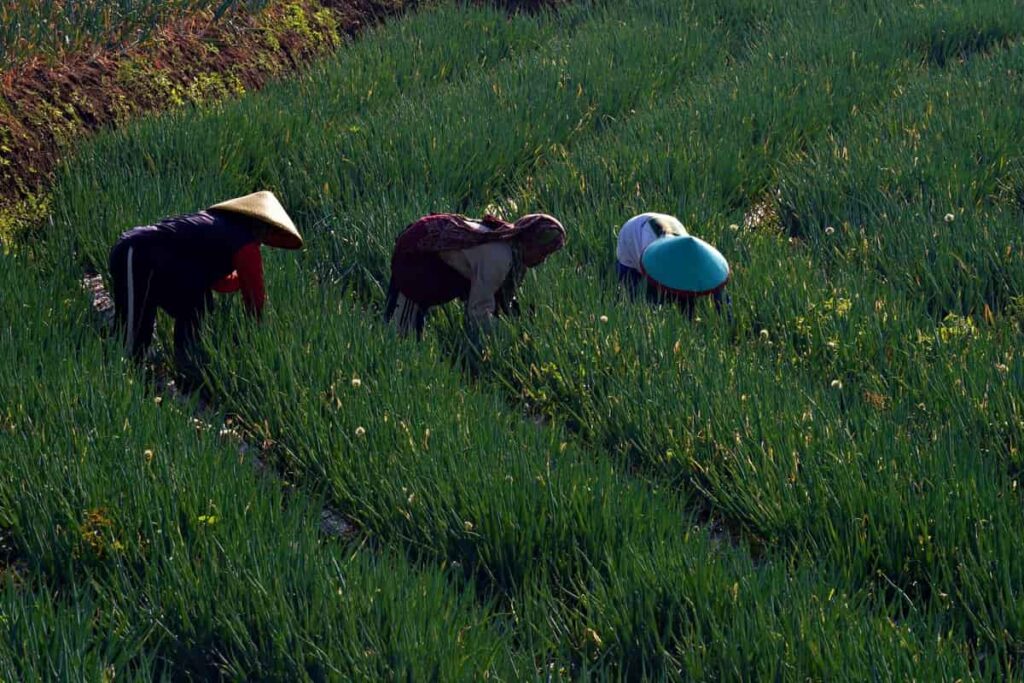
Where do onions grow best in Kenya?
Onions are a popular crop in Kenya and can be grown in many different areas. However, they do best in plenty of sunshine and well-drained soil. Onions need at least six hours of sunlight each day to grow well. Onions prefer soil that is high in nutrients or organic matter and drains well.
If your soil doesn’t drain well, you can improve it by adding organic matter such as compost or manure. Kenya is a large country with many different climate zones. Onions can be grown in most of these zones, but they will do best in areas with warm weather for most of the year.
Onion farming in Kajiado
Onion farming in Kajiado County is an important economic activity and a way of life for many farmers. Most onion farmers in Kajiado are small-scale farmers who rely on traditional farming methods. However, there are a few large-scale commercial onion farms in Kajiado. Onion farming in Kajiado County is mostly rain-fed. The main onion-growing areas in Kajiado are the Machakos and Makueni valleys. These areas have deep, well-drained soils and receive enough rainfall to support onion farming.
Onion farmers in Kajiado use various irrigation methods, including drip irrigation, sprinkler irrigation, and flood irrigation. The main challenges faced by onion farmers in Kajiado are soil fertility decline, water shortages, and pests and diseases. To overcome these challenges, farmers must adopt good agricultural practices, such as crop rotation, organic fertilizers, and pesticides.
How profitable is onion farming in Kenya
According to recent studies, onion farming can be quite profitable in Kenya. Onions are one of the country’s most commonly grown crops, and farmers can earn a good income from selling them. Onions are generally easy to grow and require little maintenance. They can be grown in various soil types and climate conditions, making them ideal for Kenyan farmers. Onions also have a long shelf life, meaning they can be stored and sold throughout the year.
In terms of profitability, onion farming can bring in good returns for farmers. For example, a farmer with one acre of land can earn around KES 30,000 to 40,000 from onion sales each year. This profit margin can increase even further if the farmer can sell their onions at higher prices. Overall, onion farming is a profitable venture for Kenyan farmers. Farmers can earn good incomes from onion sales with minimal investment and effort.
How many months does it take onion to mature in Kenya?
It takes onion about four to six months to mature in Kenya. This is because Kenya’s climate and soil type are conducive to growing onions. However, the length of the maturing process may vary depending on the variety of onions planted.
In case you missed it: High Yield Hybrid Grapes Varieties in India: State Wise Varieties Cultivated
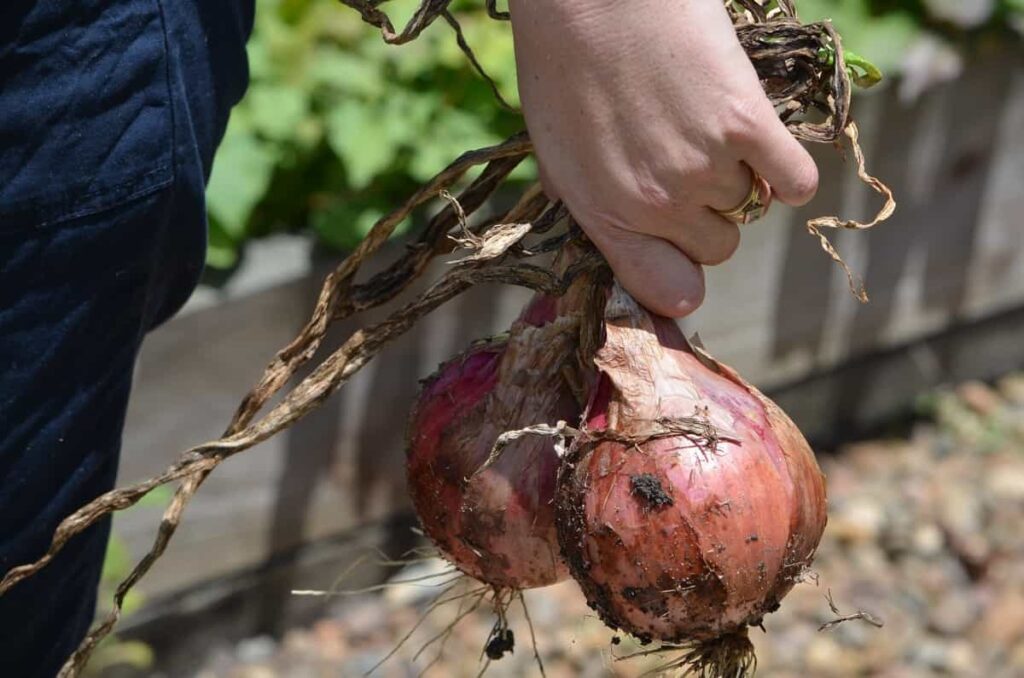
Which is the best onion variety in Kenya?
Wide onion varieties are grown in Kenya with unique flavors and textures. While there is no exacte answer to the best onion variety in Kenya, we can narrow it down to a few contenders. One of the most popular onion varieties in Kenya is red onion. Red onions are grown throughout the country and are known for their sharp, spicy flavor. They are often used in cooking to add a deep flavor to dishes.
Another popular onion variety in Kenya is the white onion. White onions are milder in flavor than red onions and have a more delicate texture. They are often used raw in salads or as a garnish on dishes. Finally, yellow onion is another variety that is commonly grown in Kenya. Yellow onions have a slightly sweeter flavor than other onions.
Common onion pest and diseases in Kenya
A number of common pests and diseases can affect onions in Kenya. These include: · Whiteflies – these small insects can infest onion plants and cause them to produce fewer onions. They can also transmit viruses to plants.
- Aphids – these small, sap-sucking insects can damage onion plants and reduce yields. They can also transmit viruses to plants.
- Thrips – these small, winged insects feed on onion leaves and flowers, causing them to turn brown and wither. They can also transmit viruses to plants.
- Onion maggots – the larvae of flies, these pests burrow into onion bulbs, causing them to rot.
- Downy mildew – this fungal disease affects the leaves of onion plants, causing them to turn yellow and eventually die.
- Fusarium root rot – this fungal disease affects the roots of onion plants, causing them to rot and eventually die.
How can I grow onions faster in Kenya?
If you want to grow onions faster, you can do a few things. First, make sure you plant your onions in well-drained soil. They also need full sun to grow well, so choose a spot in your garden that gets at least 6 hours of sunlight daily. Next, water your onions regularly with good fertilizers them every few weeks to give them a boost.
You can also add some organic matter or compost to the soil, such as compost or manure. Finally, ensure you thin out your onions when they crowd each other. This will help them grow larger and faster. With these tips and ideas, you should be able to grow delicious onions in no time!
How and When to harvest onions in Kenya?
Kenya country is located in East Africa. The climate there is tropical, with two rainy seasons per year. Onion cultivation is possible throughout the year, but the ideal time to plant onions is during the first rains, which usually fall in late March or early April. The second rains occur from late October to mid-November. Harvesting onions in Kenya generally takes place about four months after planting, though this will vary depending on the variety of onions and the location.
Onions are usually ready to harvest when the leaves start to yellow and fall over. Farmers first loosen the soil around the plant to harvest onions using a hoe. They then pull the onion up by the stem, careful not to damage the bulb. Onions are typically dried in the sun for a few days before they are stored or sold.
How many onions can you harvest from one plant in Kenya?
The answer depends on couple of factors, including the type of onion you’re growing and the conditions on your farm. On average, you can expect to harvest 10 to 15 onions from each plant. However, if you’re growing a larger variety of onions or if conditions are ideal on your farm, you could harvest up to 20 onions from each plant.
In case you missed it: White Onion Farming in India: Grow Onions Bigger, Faster and Onion Growing Duration
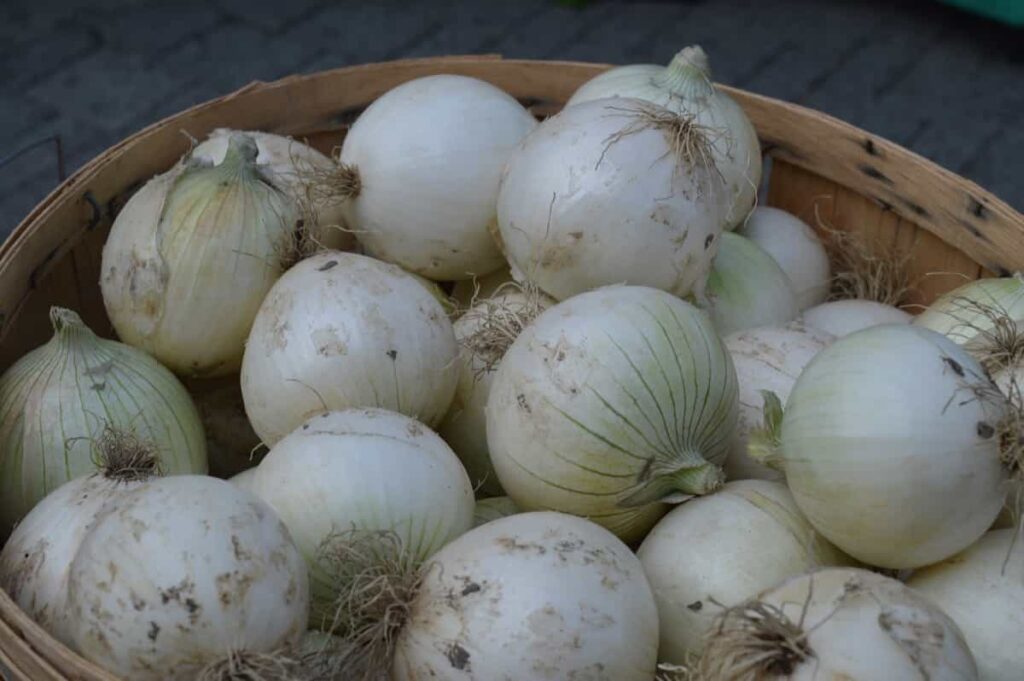
The yield of onions per acre in Kenya
According to the National Horticultural Research Institute, the average yield of onions per acre in Kenya is between 35 and 40 tonnes. However, yields can vary significantly depending on the variety of onions, the soil type, the conditions, and the farming practices used. For example, small-scale farmers who use traditional methods may only achieve yields of 10-20 tonnes per acre, while large-scale farmers using modern techniques can achieve yields of up to 60 tonnes per acre.
How many tons of onions do you get per acre in Kenya?
Onions are a staple in Kenyan cuisine and are grown extensively throughout the country. Kenya’s average yield of onions per acre is about 10 to 20 tons. However, this can vary depending on the variety of onions, the soil type, and the climate.
Where to sell onions in Kenya?
Kenya is a renowned exporter of fresh produce, and onions are one of the country’s main exports. There are several ways to sell onions in Kenya, depending on the quantity you have to sell and your preferred method of sale. The most common way to sell onions in Kenya is through wholesale markets. These are typically located in major cities, such as Nairobi, and onion sellers can take their produce there to sell to wholesalers.
This is often the best option for those with large quantities of onions to sell, as it allows them to reach a wide audience of potential buyers. Another option for selling onions in Kenya is through online platforms. Some websites allow farmers and other producers to list their products for sale, and buyers can browse these listings and purchase items they are interested in. This can be a good option for those with smaller quantities of onions to sell, as it allows them to reach a global audience of potential buyers.
Finally, another option for selling onions in Kenya is through direct sales. This involves finding buyers interested in purchasing your onions and selling them directly to them. This can be done through personal connections or advertising your onions for sale in local newspapers or online. This option is often best for those with smaller quantities of onions to sell, as it allows for more flexibility in terms of price and payment methods.
Conclusion
Kenya is a country with many farmers who grow onions. The farmers in Kenya have been able to produce a good crop of onions for the past few years. With a proper onion farming business plan, you can get good profits in the onion cultivation sector.
- Crops Grown in Summer Season: Best Choices for Summer Gardening
- Organic Pest Control for Tomato Farming
- How to Maximize Sheep Farming Profit
- Broccoli Varieties: Choosing the Right Cultivars for Your Farm
- How to Raise Pigs in Your Own Backyard: A Comprehensive Guide
- Budget Friendly Sheep Shed Ideas: Cheap and Low-Cost Tips
- How Much Do Cattle Farmers Make: Revenue Streams in Cattle Farming
- Management Pests and Diseases in Your Cotton Field
- Sheep Farming Business Plan for Beginners
- Aquaponic Farming at Home: A Step-By-Step Guide
- Profitable Village Farming Business Ideas in 2024
- High-Yield Aquaculture: Fast-Growing Fish for Farming
- Effective Fish Pond Construction Techniques for Beginners
- Irrigation and Water Management in Pineapple Farming
- Blossom to Harvest: Mastering Flowering and Pollination in Papaya Farming
- Pig Fattening Essentials: From Selection to Sale for Beginners
- Raising Wagyu Cattle: A Complete Guide for Premium Beef Production
- Soil Types and Their Water Holding Capacity
- Optimizing Irrigation Schedules for Coconut Groves for Enhanced Yield
- Espresso Your Garden: Coffee Grounds for Healthier Acid-Loving Plants
- The Best Soil Mix for Snake Plants: How to Mix Your Own Snake Plant Soil
- Green Thumb Success: Expert Tips for Cultivating Greenhouse Beans All Year Round
- Bloom All Year Round: The Ultimate Guide to Indoor Hyacinth Care
- Eco-Friendly Gardening: How to Make Liquid Fertilizer from Kitchen Waste
- Ultimate Guide to Grow Anise in Pots: Explore Seed Propagation to Harvesting
- Guide to Raising Chester White Pigs: Discover Breed Facts to Growth Management
- Mastering the Elegance: The Ultimate Guide to Weeping Cherry Tree Care, Planting, and Maintenance
- Ultimate Guide to Planting Garlic in Grow Bags: Growing Strategies for Beginners
- How to Fix Spider Plant Leaf-Related Problems: Natural and Organic Remedies
- 10 Reasons Why Your Tulsi Plant is Shedding Leaves: Home Remedies and Solutions
- Optimizing Growth and Yield: The Advantages of Palm Bunch Ash Fertilizer
- Utilizing Neem Oil Extract as a Natural Pesticide for Hydrangea
- From Soil to Harvest: Various Ways in Which Farmers Can Use AI Tools
- Steps to Encourage and Induce Citrus Flowers: A Comprehensive Guide
- How to Fix Snake Plant Leaf-Related Issues: Natural and Organic Remedies
- Transform Your Garden into a Fragrant Oasis with Raat Ki Rani (Night Blooming Jasmine)

Planting of onions
Have learned a lot, kindly continue giving me more updates.
Regards